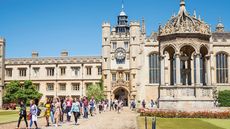Invest in the clever and connected smart cities of the future
Smart cities are no longer futuristic fantasies. Chris Carter analyses their rapid development and explains how you can profit from them.


The "smart city" is no mere futuristic fantasy, but a work in progress. Chris Carter analyses the trend's rapid development and explains how you can profit from it.
The lights in the bedroom gradually brighten and you wake up feeling refreshed. You know you've slept well: the fitness and sleep tracker on your wrist says so. Downstairs in the kitchen, your refrigerator places an order for more orange juice just as you upend the last drop from the carton into your glass. The coffee-maker gurgles into action right on cue. After breakfast, the mirror in the bathroom bids you good morning and informs you that road-traffic sensors are reporting light traffic, while the leaves on the railway lines have been swept away. All trains are running on time. Oh, and the weather will be warm. So might the wardrobe suggest you wear summer clothes today? The sun is shining as you step outside. The car has charged overnight, when electricity is cheaper. It starts with a hum at the press of a button and you're off on your way to work.
A technological ecosystem
Thus begins a typical day in a "smart city", which uses technology in an interconnected way to make life better and smoother for everyone. In some ways, the smart city is the logical end point to the so-called "internet of things" (IoT), whereby everything from your kettle to vacuum cleaner is hooked up to the internet. Your own environment is seamlessly connected to the city's. "I do not see a smart city as a top-down planning exercise, but as an ecosystem," Carlo Ratti of the Massachusetts Institute of Technology Senseable City Lab, and co-chair of the World Economic Forum's Global Future Council on Cities and Urbanisation, tells The Economist Intelligence Unit. It's an ecosystem in which we can all hope to thrive.
Subscribe to MoneyWeek
Subscribe to MoneyWeek today and get your first six magazine issues absolutely FREE

Sign up to Money Morning
Don't miss the latest investment and personal finances news, market analysis, plus money-saving tips with our free twice-daily newsletter
Don't miss the latest investment and personal finances news, market analysis, plus money-saving tips with our free twice-daily newsletter
Most of the technology underpinning a smart city already exists or is being trialled in a city near you.
London, for instance, has "taken great steps already", as Mayor Sadiq Khan noted in the foreword to his Smarter London Together document last summer. "But I want us to do even more to utilise data and smart technology to meet the needs of our citizens," he continued. "I see London's future as a global test-bed city' for civic innovation, where the best ideas are developed, amplified and scaled." It all has the air of some Silicon Valley visionary billionaire giving a TED talk to a roomful of open-mouthed acolytes. Khan wants London to become "the smartest city in the world". Smarter London Together seeks to use information and communication technologies (ICT) not only to solve the biggest problems facing the city any big city in the 21st century, but also to improve efficiency in terms of money and energy use.
Why we need them
Two demographic trends are driving the development of smart cities. Firstly, populations are getting bigger. Much bigger. The number of people on the planet is projected to reach 9.7 billion by 2050, according to the United Nations. That isn't all that far away. The world population stands at around 7.7 billion today, so that's just over a quarter more people on what is already a pretty crowded Earth. Or to put it another way, we are set to add the current populations of Europe and Africa to the mix. And in 2008, the global rural population equalled the urban population for the first time in human history as more and more people headed for the bright lights of the city in search of work and a better standard of living.
The other great demographic trend is that populations are getting older. That's especially true in developed countries. In 1997, one in six people in Britain was aged 65 years or over, according to the Office for National Statistics. By 2017, that figure had risen to one in five. And by 2037, the over-65s will account for a quarter of the population.
Making life easier
Advances in technology should make life easier for everyone, not just older people. One example is a more efficient bus network. From June to September last year, Transport for London (TfL) ran a test project whereby small computers were installed on buses to process images taken using the onboard CCTV cameras in order to undertake an accurate passenger count. TfL also made a note of how many people were using their smartphones to connect to a Wi-Fi network. No information that could be used to identify individuals was kept. Instead, the data was used, in the words of TfL, to "better understand how many customers there are and how they are using our bus network". On the railways, the Department for Transport is funding a trial project that uses artificial intelligence (AI) to predict when trees might fall across the tracks. A camera sits in the driver's cabin and inspects the vegetation as the train trundles past. Leaves can also be swept off the lines before they ruin the mornings of millions of fed-up commuters.
Admittedly, new is not always better at least not to begin with. When The Spectator's James Delingpole recently broke down on an "all lane running" (ALR) smart motorway (where the hard shoulder had been converted into a fourth lane), it took an hour before help arrived. In theory, "newfangled" cameras should have spotted him and sent for help, while also warning drivers behind of the broken-down vehicle up ahead. In Delingpole's case, "from the way the traffic moved" there was no "indication that the overhead gantries had been deployed to close the lane. (Either that or, as quite often happens, drivers were... ignoring the red X sign)", he says. Should these teething problems be overcome, there are cost advantages to using the technology, as Delingpole grudgingly agrees: "About the only people who seem to like smart motorways are the bean counters at Highways England (formerly the Highways Agency)". But the technology should also lead to more efficient road usage and fewer new roads needing to be built.
Increasingly, you don't even need to leave the house to feel the effects of technology. The smart city comes to you. As of last April, for instance, anybody in Britain can now get immediate advice and information about government services just by asking the voice-activated digital assistants, Amazon's Alexa and Google Assistant, from their armchairs. That's thanks to a small team from the Government Digital Service, who spent six months setting it up. You can now, for instance, find out how to get a passport. It's an ongoing project, but the range of services will only get better as technology improves.
Saving the planet
Of course, all these extra people the resources they consume and the waste they generate take their toll on the planet. Luckily, more efficient transport networks in combination with evolving technologies should help to make our carbon footprint a little lighter. Cars already switch off their engines when sitting at traffic lights, or have gone electric altogether. And it's not just with transport that smart technology will play a vital role. In the home, for example, we can already set our thermostats remotely to minimise the amount of energy we use, or install sensors in the workplace to turn off the lights when no one is around. But if Britain is going to hit the government's much-vaunted target to achieve net-zero carbon emissions by 2050, then the way we interact with technology is going to have to develop even further either that or we radically change our habits, by, for example, taking fewer flights. Given that it goes against the grain of human nature to deprive ourselves of things that are cheap and readily available, improving technology is imperative.
Will smart cities spy on us?
So far so good. But there is, of course, a flipside to all this new technology. If smart-city technology can be used to make the lives of its citizens better, can it also be used to encroach on civil liberties? If a computer on a bus can process images of passengers to count them, then presumably it could also be used to identify them. Indeed, in some countries it's already happening. In issue 954 of MoneyWeek, my colleague Ben Judge looked at how the Chinese government has "enthusiastically" embraced facial recognition technology to identify "anyone, anytime, anywhere in China within three seconds", as the South China Morning Post put it. It's a frightening prospect.
A backlash is building
It's hard to imagine a more peaceful, more benign place to live than Canada. So when Sidewalks Labs, a subsidiary of Google's parent company Alphabet, last month unveiled plans to turn the Quayside area of Toronto into, as the Financial Times puts it, "a data-driven smart city of the future", you wouldn't have expected people to make much of a fuss.
It all sounds fine on paper. According to the plans, the city will be crammed with cameras and sensors, so that the kerbsides can expand and contract depending on road traffic. This is possible because the kerbsides are level with the road and the pavement is embedded with LED lights that can be lit or not, depending on road traffic, thus increasing or decreasing the amount of space for vehicles and pedestrians. There will be an underground "logistics hub" for subterranean deliveries. Above ground, the pavements will be heated against the freezing Canadian winter, and the buildings either side will be made of environmentally friendly wood. The project would cost C$3.9bn (£2.4bn), but ultimately generate C$4.3bn in annual tax revenues and add C$14.2bn to Canada's GDP.
But not everyone is impressed. "This is not a road map for a smart city, it's an assault on our democracy", Jim Balsillie, a former chief executive of BlackBerry, told The Guardian. He argues that the plans are a land grab for "more power and more control". Several high-profile members of a board set up to guide the project have resigned, says the paper, and "critics have also questioned how Sidewalk Labs will capture and use data in the neighbourhood and how intellectual property rights will be handled". It's not only intrusion by the state that people fear, but intrusion by big business.
Room for improvement
Still, we don't have to wait for the Quayside development to see how a purpose-built smart city can go wrong. We already have an example in Songdo, a city close to Seoul in South Korea. Connected to the new Incheon International Airport, opened in 2001, Songdo was to become a model for attracting trade, particularly with Korea's colossal neighbour. "Viewed from the sky, its street grid forms an arrow aimed straight at the heart of coastal China. It is a kind of... feng shui diagram, drawing energy from the rapidly urbanising nation just over the western horizon," says Anthony Townsend in his 2013 book Smart Cities: Big Data, Civic Hackers, and the Quest for a New Utopia. "Massive in its own right, Songdo is merely a test bed for the technology and business models that will underpin the construction of pop-up megacities across Asia." Sadly, it hasn't panned out that way.
The Wall Street Journal recently reported that "17 years and more than $20bn later less than half of the planned office space has been built, and existing offices have a vacancy rate of more than 30%". The partnership between real-estate developers Gale International and Posco Engineering & Construction has collapsed into acrimony and lawsuits amid accusations of inflated construction costs and back-stabbing. The dream of Songdo becoming an international centre of business and finance now all but lies in tatters, says The Wall Street Journal's Peter Grant.
Get in early
This certainly does not mean, however, that smart cities will never get off the ground. Grand projects nearly always falter somewhere along the way, after all, and the rationale for smart cities remains compelling: it's hard to see how the planet can cope with a rapidly-growing, urbanising and ageing population without harnessing technology in order to live more efficiently than we do now. Equally, while it's impossible to know how societal concerns about the trade-offs between privacy and convenience will play out, not all of the more grandiose or intrusive elements of smart city design need become reality in order to make the theme a profitable one if even a few of these technologies are adopted more widely, it could be transformative for the companies involved. We highlight some possible plays below.
The smartest picks
When it comes to installing the "plumbing" for a smart city, few companies are more qualified than Cisco Systems (Nasdaq: CSCO). The telecoms giant is the "master plumber of the internet", as Townsend puts it, having been involved in the creation of internet infrastructures since the earliest days. As smart cities continue to expand, so should Cisco.
Earnings per share (EPS) are forecast to grow from $2.6 last year to $3.4 in 2020. The share price has risen by a third already this year. But Cisco's price/earnings (p/e) ratio of 21 is forecast to fall to 19. The shares may yet have further to go.
In Britain, BT (LSE: BT.A) is still reeling from an accounting scandal two years ago. The share price has fallen by a fifth since the start of 2019. But BT has spent years developing its broadband service, and the company says it is "researching and investigating smart cities" through projects in Milton Keynes and Manchester. Moreover, Britain has shown it is keen to open its door to innovative technologies. So smart cities could prove lucrative if BT can grab a slice of the action. With a p/e ratio of less than nine, and a new boss in Philip Jansen at the helm, BT could be ripe for a turnaround. The stock is one for the watch list.
Siemens (Frankfurt: SIE) has been another big name in the smart-city arena for years, as has IBM (NYSE: IBM). Despite the share price having risen by almost a quarter this year, the original software giant is still only on a p/e ratio of ten. If you would rather let somebody else do the work, then the £768m Pictet SmartCity fund (see below) is well worth a look. Its top five holdings are Vonovia (a German property company), Visa, Cisco Systems, Worldpay and Mastercard. It charges an annual fee of 0.98%.
A theme based on powerful structural trends
Last August, Pictet Asset Management launched its SmartCity fund. Below, we ask Stephen Freedman, senior product specialist, thematic equities, five questions.
Why should investors put their money in smart cities?
The smart-city theme is underpinned by powerful structural trends. These include urbanisation; cities will acquire an additional two-billion inhabitants by mid-century. It is also driven by the growing focus on sustainability and technological advances to solve societal problems. Companies that support smart approaches to urbanisation or offer solutions to social challenges should enjoy long-term growth.
Can investors still find value?
The focus on smart cities by the investment community is still in its early days. We believe there is plenty of value.
What do you look for in your investments?
We look for businesses with sustainable profitability, strong management and attractive financials. We seek to maintain a healthy balance within the portfolio between cyclical and defensive names.
How have you organised your portfolio?
It is divided into three categories. One is "Building the city". This comprises firms focusing on urban development and intelligent buildings."Running the city" concerns traditional infrastructure, digital infrastructure and mobility solutions. Finally,"Living in the city" deals with housing solutions, intelligent workplaces and urban lifestyles.
Which is your favourite investment and why?
One company we like to highlight is Bright Horizons Family Solutions (NYSE: BFAM). This US-based operator of childcare facilities is specialised in providing its services at the worksites of blue-chip companies. It is in the intelligent workplace section of the portfolio.
Cities are where a disproportionate share of economic activity takes place. For instance, the New York City metro area is estimated to account for about 10% of US GDP. Therefore companies that improve the efficacy and convenience of the workplace can contribute significantly to the quality of urban life.
Bright Horizons' business model is attractive owing to the low cyclicality of underlying demand, high pricing power as clients are dependent on the service and the fact that partnering with employers reduces investment needs.
The company also benefits from the trend toward increased female participation in the workforce. Against this backdrop, earnings per share has been growing in excess of 20% per annum over the last three years.
Chris Carter spent three glorious years reading English literature on the beautiful Welsh coast at Aberystwyth University. Graduating in 2005, he left for the University of York to specialise in Renaissance literature for his MA, before returning to his native Twickenham, in southwest London. He joined a Richmond-based recruitment company, where he worked with several clients, including the Queen’s bank, Coutts, as well as the super luxury, Dorchester-owned Coworth Park country house hotel, near Ascot in Berkshire.
Then, in 2011, Chris joined MoneyWeek. Initially working as part of the website production team, Chris soon rose to the lofty heights of wealth editor, overseeing MoneyWeek’s Spending It lifestyle section. Chris travels the globe in pursuit of his work, soaking up the local culture and sampling the very finest in cuisine, hotels and resorts for the magazine’s discerning readership. He also enjoys writing his fortnightly page on collectables, delving into the fascinating world of auctions and art, classic cars, coins, watches, wine and whisky investing.
You can follow Chris on Instagram.
-
 British Airways revamps Avios scheme bringing down flight prices to £1
British Airways revamps Avios scheme bringing down flight prices to £1With the new Avios part-payments scheme you can now bag a British Airways flight for as little as £1
By Oojal Dhanjal Published
-
 RBS to close a fifth of branches
RBS to close a fifth of branchesRoyal Bank of Scotland plans to shut 18 branches across Scotland, resulting in the loss of 105 jobs. We have the full list of closures.
By Ruth Emery Published
-
 Invest in space: the final frontier for investors
Invest in space: the final frontier for investorsCover Story Matthew Partridge takes a look at how to invest in space, and explores the top stocks to buy to build exposure to this rapidly expanding sector.
By Dr Matthew Partridge Published
-
 Invest in Brazil as the country gets set for growth
Invest in Brazil as the country gets set for growthCover Story It’s time to invest in Brazil as the economic powerhouse looks set to profit from the two key trends of the next 20 years: the global energy transition and population growth, says James McKeigue.
By James McKeigue Published
-
 5 of the world’s best stocks
5 of the world’s best stocksCover Story Here are five of the world’s best stocks according to Rupert Hargreaves. He believes all of these businesses have unique advantages that will help them grow.
By Rupert Hargreaves Published
-
 The best British tech stocks from a thriving sector
The best British tech stocks from a thriving sectorCover Story Move over, Silicon Valley. Over the past two decades the UK has become one of the main global hubs for tech start-ups. Matthew Partridge explains why, and highlights the most promising investments.
By Dr Matthew Partridge Published
-
 Could gold be the basis for a new global currency?
Could gold be the basis for a new global currency?Cover Story Gold has always been the most reliable form of money. Now collaboration between China and Russia could lead to a new gold-backed means of exchange – giving prices a big boost, says Dominic Frisby
By Dominic Frisby Published
-
 How to invest in videogames – a Great British success story
How to invest in videogames – a Great British success storyCover Story The pandemic gave the videogame sector a big boost, and that strong growth will endure. Bruce Packard provides an overview of the global outlook and assesses the four key UK-listed gaming firms.
By Bruce Packard Published
-
 How to invest in smart factories as the “fourth industrial revolution” arrives
How to invest in smart factories as the “fourth industrial revolution” arrivesCover Story Exciting new technologies and trends are coming together to change the face of manufacturing. Matthew Partridge looks at the companies that will drive the fourth industrial revolution.
By Dr Matthew Partridge Published
-
 Why now is a good time to buy diamond miners
Why now is a good time to buy diamond minersCover Story Demand for the gems is set to outstrip supply, making it a good time to buy miners, says David J. Stevenson.
By David J Stevenson Last updated